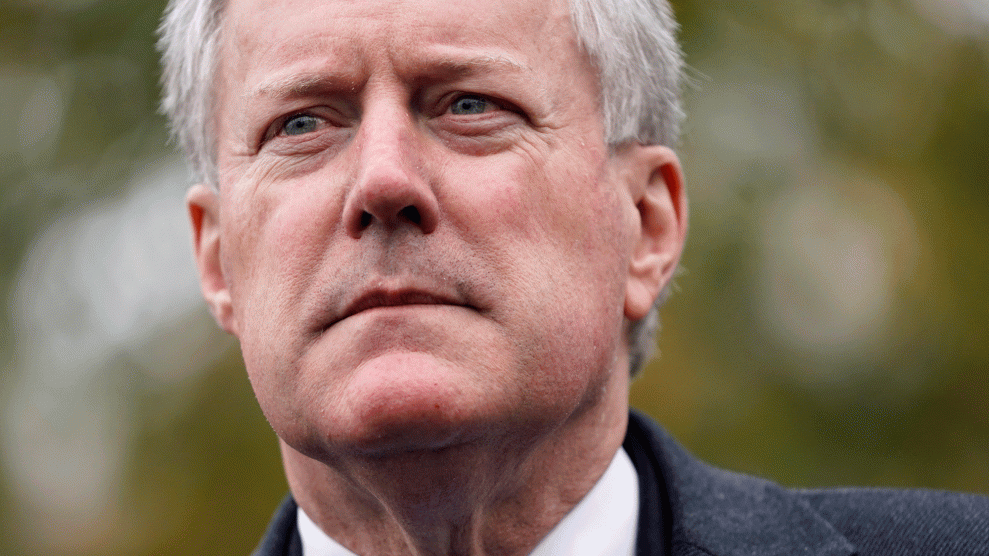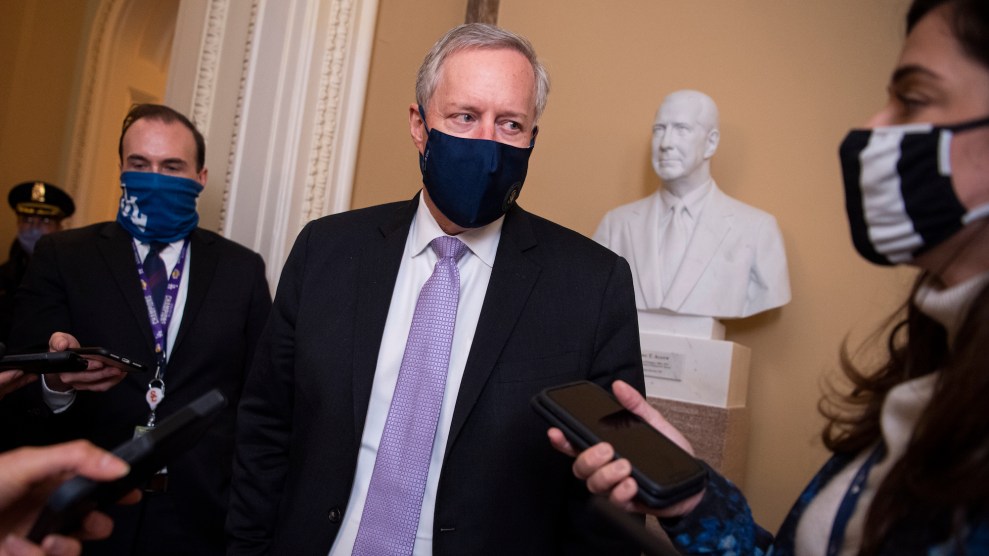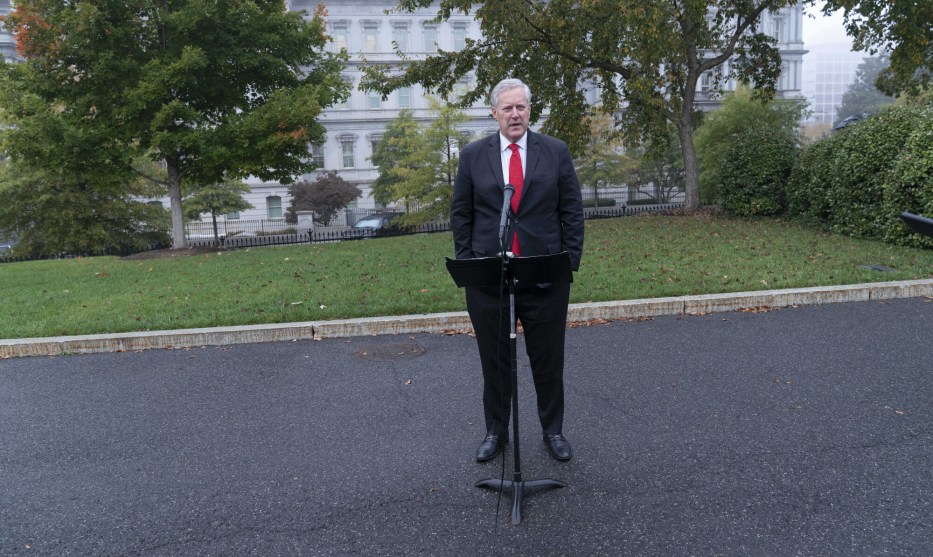
Patrick Semansky/AP
Mark Meadows, call your publisher.
It seems that Donald Trump’s final White House chief of staff left out some critical information in The Chief’s Chief, his new book chronicling his 10 months as Trump’s number-one factotum. On Monday evening, as the House committee investigating the January 6 attack was deliberating on whether to cite Meadows for criminal contempt for refusing to testify before it, Rep. Liz Cheney, one of the two Republicans on the panel, read a series of text messages that Meadows received during those horrific hours when Trump supporters were violently assaulting the US Capitol and trying to shut down the certification of Joe Biden’s victory. The texts portray a harrowing stretch and indicate that Trump, as Cheney noted, had been derelict in his duty as commander in chief by not taking actions to stop his rioting loyalists.
This is not how Meadows depicts January 6 in his own account, which devotes only a few pages to that day. He describes the pre-attack speech Trump delivered across from the White House—in which he whipped up the crowd with the Big Lie that the election had been stolen from him and urged the mob to head to the Capitol—as merely a final get-together between Trump and his supporters: “[H]e wanted to make sure that all those people he had met over his four years—the ones who had shown up to every rally, listened to his speeches, and written him letters about their frustrations with the establishment—would have one more chance to come together, make their voices heard, and encourage each other.”
Meadows is lying. For weeks, Trump-allied groups had been promoting this event as a chance to “save America” and “stop the steal,” not a fond farewell. In tweets, Trump had been encouraging people to attend. On December 19, he had tweeted, “Big protest in D.C. on January 6th. Be there, will be wild!” Meadows forgets to mention this tweet.
He characterizes Trump’s speech that day as calm: “[I]t was not ranting demands that came out of his mouth; if anything, he was more subdued than usual, simply stating his points and letting the crowd know that he was not going to give up on America, or on them.”
Was Meadows paying attention? As the AP noted, Trump’s tone and substance were “incendiary.” This is how the news service describes Trump’s remarks: “For more than an hour, Trump made the case that he and his supporters at the rally had been ‘cheated’ and ‘defrauded’ in the ‘rigged’ election by a ‘criminal enterprise’ made up of some of the ‘weak’ legislators the insurrectionists were about to confront.” When his supporters chanted, “Fight for Trump,” he thanked them. Meadows quotes a passage of that speech in which Trump criticized the media—“It’s not fair. It suppresses thought…and it’s become the enemy of the people”—yet he says nothing about Trump’s long diatribe citing alleged, but disproven, instances of election fraud.
In his book, Meadows refers to the subsequent assault on the Capitol as the “actions of a handful of fanatics across town who had decided—all on their own, by the way, with absolutely no urging from President Trump—to break into the Capitol Building to try to wreak havoc.” (Define “handful,” Mr. Meadows.) He states that what happened on Capitol Hill “was shameful.” Then he turns to what Trump did as his devotees were marauding through the Capitol, beating police officers, calling for the lynching of Vice President Mike Pence, and attempting to thwart the Constitution… Actually, he doesn’t. Meadows’ account includes nothing on how Trump reacted to this domestic terrorism or what actions he took throughout that long and ugly afternoon. And there is not a word about anything Meadows himself did during the riot. Nada.
That’s rather odd. This was one of the most dramatic episodes of Trump’s presidency and of Meadows’ stint in the White House. And the guy doesn’t share one detail. Yet now, thanks to the January 6 committee, the public knows a little more about what Meadows’ day was like.
As Trump’s brownshirts stormed the citadel of American democracy, Meadows received a flow of messages and cries for help from people inside the Capitol, including legislators. One text informed him, “We are under siege here at the Capitol.” Another read, “They have breached the Capitol.” And another: “Mark, protesters are literally storming the Capitol. Breaking windows on doors. Rushing in. Is Trump going to say something?” A fourth exclaimed, “There’s an armed standoff at the House Chamber door.” A fifth: “We are all helpless.”
Dozens—dozens—of texts, including some from Trump administration officials, pleaded for action. “POTUS has to come out firmly and tell protesters to dissipate. Someone is going to get killed.” “Mark, he needs to stop this. Now.” “TELL THEM TO GO HOME.” “POTUS needs to calm this sh*t down.” Donald Trump Jr. texted Meadows, “He’s got to condemn this shit ASAP.” Meadows replied, “I’m pushing hard. I agree.” But when Trump took no such steps, Trump Jr. texted Meadows repeatedly. In one message, he urged, “We need an Oval Office address. He has to lead now. It has gone too far and gotten out of hand.”
Fox News hosts also pushed Meadows for action from Trump. Laura Ingraham texted, “Mark, the President needs to tell people in the Capitol to go home. This is hurting all of us. He is destroying his legacy.” Brian Kilmeade beseeched, “Please get him on TV. Destroying everything you have accomplished.” And Sean Hannity sent a message: “Can he make a statement? Ask people to leave the Capitol.”
What a dramatic afternoon. Meadows was being besieged by lawmakers, fellow Trump officials, the stars of Fox News, and the president’s eldest son. Why would he leave all this out of his book? It’s gripping. It’s suspenseful. And why not reveal to his readers how he reacted to these pleas and what he did—or didn’t do—in response?
Meadows in the book presents no information to counter the impression Trump purposefully dawdled to see if the riot might work to his advantage and forestall the certification of Biden’s win. He does not address the various reports that cast Trump in a dark light: that Trump was practically giddy as he watched the violence on television, that when House GOP leader Kevin McCarthy urged Trump to intervene to halt the rampaging, he replied, “Well, Kevin, I guess these people are more upset about the election than you are.”
Meadows is hiding what happened in the White House on January 6. It’s no wonder he does not want to testify. Trump’s failure to act that day—to heed all those pleas—is also Meadows’ failure.
This book is disinformation. Meadows peddles Trump’s propaganda. “I knew he didn’t lose,” Meadows declares of Trump and the 2020 election. How did he know this? The “excitement of the people” at Trump’s campaign rallies had been “palpable.” He says he had “spoken with dozens of peoples during those rallies” and they were “thrilled to be together.” (They were also “some of the kindest, most generous people I had ever met.”)
He accuses unnamed Democrats of conspiring before Election Day to use fraudulent votes to lock in a Biden victory—without providing any evidence of this plot. He claims there were “thousands of allegations of widespread fraud.” He writes that Trump only raised “legitimate concerns about the way our elections are run,” not bizarre rumors or speculation. And he maintains that Democrats—again, unnamed—had a plan not only to rig the election but to cover up their skullduggery: they used allies within the media to deride Trump claims of ballot fraud as nothing but unhinged conspiracy theories. And, Meadows contends, the media had been preparing for this moment for years by branding Trump and his supporters as crazy and paranoid. “[I]t became clear that the media’s plan—the ‘long con’—had worked,” he writes. “Soon, anyone who had questions about the election was labeled a nutcase.” Get it? The media had been painting Trump and his crew as kooks so that when the Dems steal the election and the Trumpers protest, no one will believe them. That was diabolical.
With his book, Meadows is conning the public. He won’t testify before Congress, but he’s peddling this collection of untruths and non-truths, rehashing Trump’s I-was-robbed swill for his audience of Trump die-hards. Still, Meadows is holding back on them. He’s not telling them—and the world—what he and their champion did on perhaps the most consequential day of Trump’s presidency. Perhaps that’s to be expected. The texts hint at negligence and malfeasance. And what Trump fan is going to pay $28 for that?
















